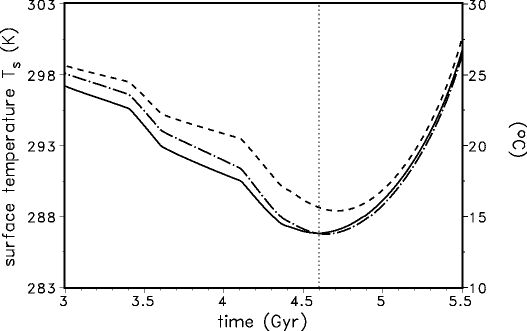 |
||||
| Werner von Bloh
|
|||||
| Long-term evolution of the global carbon cycle: historic minimum of global surface temperature at present |
|
||||
S. Francka, K. J. Kossackib, W. von Bloha, and C. Bounamaa aPotsdam Institute for Climate Impact Research (PIK), Telegrafenberg, P.O. Box 60 12 03, 14412 Potsdam, Germany. bInstitute of Geophysics of Warsaw University, Pasteura 7, 02-093 Warsaw, Poland. We present a minimal model for the global carbon cycle of the Earth containing the reservoirs mantle, ocean floor, continental crust, continental biosphere, the kerogen, as well as the aggregated reservoir ocean and atmosphere. This model is coupled to a parameterised mantle convection model for describing the thermal and degassing history of the Earth. In this study the evolution of the mean global surface temperature, the biomass, and reservoir sizes over the whole history and future of the Earth under a maturing Sun is investigated. We obtain reasonable values for the present distribution of carbon in the surface reservoirs of the Earth and find that the parameterisation of the hydrothermal flux and the evolution of the ocean pH in the past has a strong influence on the atmospheric carbon reservoir and surface temperature. The different parameterisations give a rather hot as well as a freezing climate on the early Earth (Hadean and early Archaean). Nevertheless, we find a pronounced global minimum of mean surface temperature at the present state at 4.6 Gyr. In the long-term future the external forcing by increasing insolation dominates and the biosphere extincts in about 1.2 Ga. Our study has the implication that the Earth system is just before the point of evolution where this external forcing takes over the main influence from geodynamic effects acting in the past.
Figure: Evolution of the global mean surface temperature, Ts, around present showing the cooling effect of the biosphere and the kerogen. The dashed line denotes the model results for constant hydrothermal flux without biosphere, the dashed-dotted one with biosphere but without kerogen, and the solid line the full model. |
|||||
|
|
|||||
| Impressum © PIK 2006 |
